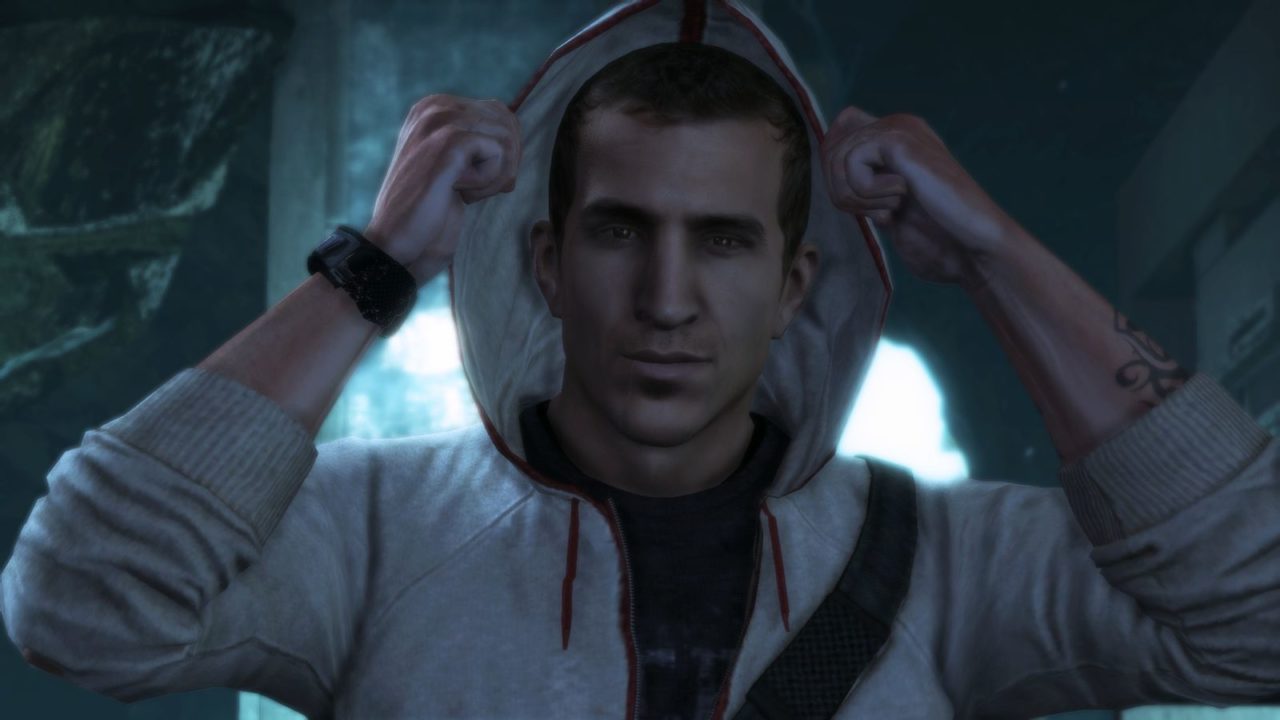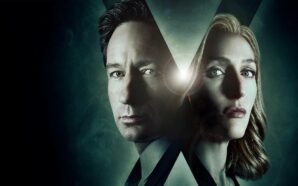Assassin’s Creed is seemingly endless. Pick an interesting point in history, drop in the duelling philosophies of the Assassins and Templars, create an open world and an engaging protagonist and boom, you’ve got yourself the next entry of a series that could continue until the end of time. As a fan of the franchise, this longevity is great. I get to continue playing new iterations of the game I love. But there’s something to be said for finality in a story. I recently went back and replayed Assassin’s Creed 3 Remastered and found the sense of narrative closure it offered refreshing. Sure, the series continues with Black Flag, but Assassin’s Creed 3 ends the franchise’s first arc. Desmond’s tale dramatically concludes and during this playthrough, eight years later, it struck me that the narrative bookend of his journey that the game offers is my favourite moment across all of Assassin’s Creed.
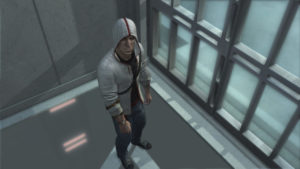 Between witnessing the past through the eyes of his ancestor and exploring the Isu’s ‘Grand Temple’, Desmond is tasked with returning to Abstergo Industries, the very same building in which he found himself imprisoned during the first game, to rescue his father and obtain the fabled Apple of Eden. It’s a daring mission which sees him retracing his steps from the breakout at the start of Assassin’s Creed 2, as he fights his way through the huge building towards his objective. Along the way he has to put all of his newfound skills to the test, face off against Daniel Cross, and return to the very room the franchise started in; before enacting revenge on Warren Vidic and finally using the power of the Apple of Eden. It’s the moment that Desmond’s entire journey has been leading towards.
Between witnessing the past through the eyes of his ancestor and exploring the Isu’s ‘Grand Temple’, Desmond is tasked with returning to Abstergo Industries, the very same building in which he found himself imprisoned during the first game, to rescue his father and obtain the fabled Apple of Eden. It’s a daring mission which sees him retracing his steps from the breakout at the start of Assassin’s Creed 2, as he fights his way through the huge building towards his objective. Along the way he has to put all of his newfound skills to the test, face off against Daniel Cross, and return to the very room the franchise started in; before enacting revenge on Warren Vidic and finally using the power of the Apple of Eden. It’s the moment that Desmond’s entire journey has been leading towards.
The sequence is the payoff to five years – and games – worth of storytelling and shows us the necessity of Desmond’s training through the bleeding effect. After essentially playing through the lives of Altair, Ezio and Connor, much like us gamers, he now has the skills to infiltrate the building and kill anyone who tries to stop him. Returning to the location in which his journey began highlights Desmond’s drastic development and begs us to examine the contrast between who Desmond was in the first Assassin’s Creed and who he has become in Assassin’s Creed 3. When he escaped Abstergo, he was a slightly podgy man struggling to fend off a couple of guards and needed rescuing by Lucy. Now he’s an Assassin, with all the abilities that title imbues. Desmond is a prisoner no longer and has instead returned to free a prisoner as Lucy once freed him. What was once a prison is now the place where we can finally be free to use Desmond’s full murderous talents, battling Abstergo guards on multiple levels and free-running across a room full of Animi (Animuses?).
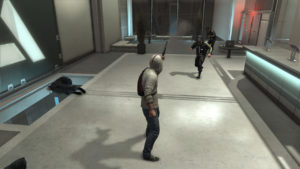 The hidden blade is the weapon of an Assassin and is never not satisfying to use, wherever you are in history, but now that the series is offering an extended action sequence set during the present-day, Desmond also comes supplied with a semiautomatic pistol. Using the hidden blade as Desmond is fantastic, with blood splatter cascading across the pure white clinical walls and the archaic weapon easily dispatching modern security guards, but the gun is a welcome addition to the mission. Desmond is a modern Assassin after all, and the weapon makes sense. You can shoot enemies from afar or up close while stabbing another enemy in John Wick-style combinations. The ‘Return to Abstergo’ mission is the closest we ever came to getting a present-day Assassin’s Creed game, other than maybe Watchdogs, and while it’s just a small taste, it quenches my thirst for such a thing. However, I do wish Desmond could execute some Altair and Ezio specific moves to show that he’s learnt from all three Assassins, rather than just copy and pasting Connor’s skillset during the gameplay (barring the gunplay), but seeing him finally unleash is incredibly satisfying.
The hidden blade is the weapon of an Assassin and is never not satisfying to use, wherever you are in history, but now that the series is offering an extended action sequence set during the present-day, Desmond also comes supplied with a semiautomatic pistol. Using the hidden blade as Desmond is fantastic, with blood splatter cascading across the pure white clinical walls and the archaic weapon easily dispatching modern security guards, but the gun is a welcome addition to the mission. Desmond is a modern Assassin after all, and the weapon makes sense. You can shoot enemies from afar or up close while stabbing another enemy in John Wick-style combinations. The ‘Return to Abstergo’ mission is the closest we ever came to getting a present-day Assassin’s Creed game, other than maybe Watchdogs, and while it’s just a small taste, it quenches my thirst for such a thing. However, I do wish Desmond could execute some Altair and Ezio specific moves to show that he’s learnt from all three Assassins, rather than just copy and pasting Connor’s skillset during the gameplay (barring the gunplay), but seeing him finally unleash is incredibly satisfying.
It’s not just Desmond who has evolved over the past five games but the series at large too. A return to its humble beginnings really shows how much has changed in terms of scale and ambition. Those small rooms in which everything occurred during the Desmond segments of Assassin’s Creed are dwarfed in comparison to the rest of the building we can now explore. Back during the days when there was only the first game, I used to walk those rooms endlessly, looking for secrets without using the Internet. The Animus room, a bedroom, a bathroom, and a conference room. That was it. What did the symbols in blood mean? How do I access the computers? Assassin’s Creed 3 allows me to briefly return to those rooms now knowing the answers to those questions. I can use eagle vision to see those symbols once again, but I now know the truth behind them and the history they unlock. As the series’ first arc wraps up, I’m shown that all the questions I had from the first game have been answered, and the potent nostalgia trip of returning to Abstergo is given a greater purpose.
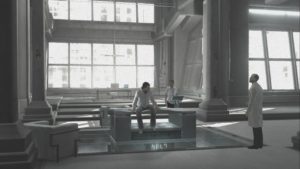 This might sound weird, but the most shocking reveal across all of Assassin’s Creed for me was looking out of the windows behind Vidic’s desk again, five years after first doing so, and seeing something totally unexpected. In Assassin’s Creed, I pondered about what blurred city lay beyond the glass. There were schoolyard rumours that if you looked out of the rightmost window for long enough a hoverbike would fly past. I’m too embarrassed to say how long I stood there waiting for such an occurrence. When Assassin’s Creed 2 came along and revealed the building was in Italy I thought, mystery solved, it’s Florence, right? Wrong. Truth is, there was never a city behind the translucent glass. It was all just a projection. A giant screen which, upon returning during Assassin’s Creed 3, now reveals nothing but a blank void and a flashing alarm light. That detail I thought about so often was a lie and Desmond was kept right in the centre of the building, yet let think that he, and us, could see the outside world. It’s a great reveal and one that makes me relate to Desmond’s past imprisonment like never before. I was manipulated along with the protagonist, and that makes me all the more invested as Desmond travels deeper into the heart of darkness to defeat his former tormentor.
This might sound weird, but the most shocking reveal across all of Assassin’s Creed for me was looking out of the windows behind Vidic’s desk again, five years after first doing so, and seeing something totally unexpected. In Assassin’s Creed, I pondered about what blurred city lay beyond the glass. There were schoolyard rumours that if you looked out of the rightmost window for long enough a hoverbike would fly past. I’m too embarrassed to say how long I stood there waiting for such an occurrence. When Assassin’s Creed 2 came along and revealed the building was in Italy I thought, mystery solved, it’s Florence, right? Wrong. Truth is, there was never a city behind the translucent glass. It was all just a projection. A giant screen which, upon returning during Assassin’s Creed 3, now reveals nothing but a blank void and a flashing alarm light. That detail I thought about so often was a lie and Desmond was kept right in the centre of the building, yet let think that he, and us, could see the outside world. It’s a great reveal and one that makes me relate to Desmond’s past imprisonment like never before. I was manipulated along with the protagonist, and that makes me all the more invested as Desmond travels deeper into the heart of darkness to defeat his former tormentor.
After battling through the building, Desmond reaches his father, who is being held at gunpoint by Warren Vidic. That is until Desmond uses the Apple to make him turn the gun on himself. Vidic’s death is a great moment, not because it ensures the Templars’ defeat (because it doesn’t), but because it’s such a personal triumph for Desmond. He used the power of item that Vidic manipulated him into locating to kill his former captor and, in my eyes, finally become a Master Assassin. Because Vidic has always been a cerebral villain, Ubisoft had to include a baddie to take on Desmond physically, and so brought in comics character Daniel Cross. Having read the comics I enjoyed this connection, but so little is revealed in the game about him. Although, it doesn’t come close to Juno’s death in the comics outrageously never being mentioned in the games. Cross just about works as an antagonist because of his comparisons with Desmond. He’s what Desmond could have been and fought against: A fallen assassin whose been mentally damaged by the bleeding effect after too much forced exposure. Putting Cross out of his misery after a brief chase seems more of a mercy than anything.
 It only just occurred to me on this recent playthrough that saving William, Desmond’s father, is a nice thematic continuation and comparison of Connor’s struggle with his father Haytham in the 1770’s. Whereas Connor and Haytham’s relationship ends in tragedy and death, Desmond and William finally manage to patch things up. Desmond leaves with his father and finally gets to hold and use the Apple of Eden. He obtained the artifact at the end of Brotherhood, but this is the first time that he controls its power, rather than it control him like when he was forced to kill Lucy. He’s transcended to the level of Ezio and Altair before him, and after fighting his way through the building, he walks out with the Apple held aloft and in literal control of the people who want to control the world, before disappearing into the night. Destiny beckons and Desmond’s end draws near after his triumphant victory.
It only just occurred to me on this recent playthrough that saving William, Desmond’s father, is a nice thematic continuation and comparison of Connor’s struggle with his father Haytham in the 1770’s. Whereas Connor and Haytham’s relationship ends in tragedy and death, Desmond and William finally manage to patch things up. Desmond leaves with his father and finally gets to hold and use the Apple of Eden. He obtained the artifact at the end of Brotherhood, but this is the first time that he controls its power, rather than it control him like when he was forced to kill Lucy. He’s transcended to the level of Ezio and Altair before him, and after fighting his way through the building, he walks out with the Apple held aloft and in literal control of the people who want to control the world, before disappearing into the night. Destiny beckons and Desmond’s end draws near after his triumphant victory.
Desmond’s story comes to an (incredibly rushed) end in the Grand Temple during the game’s final minutes, but really his character journey ends upon his return to Abstergo. Gameplay wise, it’s a very fun mission to play, and a delight to experience a brief portion of present-day assassinating in a game otherwise concerned with being an historical epic. All of Desmond’s training finally pays off as he rescues his father and accepts the Assassin responsibility that he once ran from, finally lifting aloft the Apple of Eden and beating his enemies in the place he was once so powerless. It’s a wonderful narrative bookend that closes out Assassin’s Creed’s clearest and most satisfying story and character arc. It’s an incredible moment and remains the franchise’s best.
What’s your favourite Assassin’s Creed moment? Is ‘Return to Abstergo’ in contention? Let me know in the comments and be sure to geek out with me about TV, movies, and video-games on Twitter @kylebrrtt.




